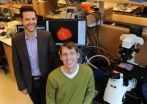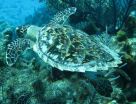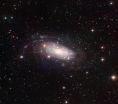(Press-News.org) Boston, MA - In work that could jumpstart the promising field of cell therapy, in which cells are transplanted into the body to treat a variety of diseases and tissue defects, researchers at Brigham and Women's Hospital (BWH) have engineered cells that could solve one of the key challenges associated with the procedure: control of the cells and their microenvironment following transplantation.
In the work, reported in the journal Biomaterials on January 26, the team reports creating tiny internal depots within human mesenchymal adult stem cells, which among other functions are key to the generation of several tissues. These depots can slowly release a variety of agents to influence the behavior of not only the cells containing the depots, but also those close to them and even much farther away. The team demonstrated this by prompting mesenchymal stem cells to differentiate into the cells that make bone.
"This work could allow programmable cell therapies where the cell or the agent is the therapeutic," says Jeffrey Karp, leader of the work and co-director of the Center for Regenerative Therapeutics (ReGen Rx) at BWH. "For example, depots containing specific agents could enhance cell survival or expression of a particular growth factor. Cells could also be used as a delivery vehicle to shuttle drugs to target tissues that may be useful to accelerate tissue regeneration, or to deliver chemotherapeutics to tumors while minimizing systemic side effects."
Toward Cell Therapy
"Ten to fifteen years from now, people will visit cell infusion centers to receive routine therapy for multiple diseases and tissue defects," predicts Karp, who also holds appointments through Harvard Medical School, Harvard Stem Cell Institute, and the Harvard-MIT Division of Health Sciences and Technology (HST). For example, a person who has had a heart attack could be infused with cells that could help stimulate regeneration of new heart cells to replace those that have died and prevent eventual heart failure.
Today, however, there is only one cell therapy that has saved tens of thousands of lives: bone marrow transplantation. In this procedure healthy blood stem cells home in to the bone marrow to regenerate the blood system of cancer patients following bone marrow ablation through chemotherapy or radiation.
One of the reasons for the lack of success of other cell therapies is the inability to control the cells and the host's response following transplantation, says Karp. "We can exhibit exquisite control over cells in a [laboratory] dish—we can get them to do whatever we want. But when we transplant them into the body, their fate and function are at the mercy of the biological milieu. We typically lose complete control and this prevents us from achieving the promise of cell therapy."
There are ways to get around this problem, but they have limitations. For example, cells can be put on a scaffold or biomaterial that releases drugs or other agents that affect their behavior. The cells, however, have to stay in close proximity to the material to be impacted by the agents. Cells can also be genetically modified with viruses to produce agents that will influence their behavior, but this has potential safety concerns.
Natural Inspiration
The Karp team was inspired by the natural ability of many proteins and other agents to be transported in and out of cells. They already knew that cells could internalize the tiny synthetic particles used in the controlled delivery of drugs—could these particles be used in cell therapy?
To find out, the researchers developed biodegradable particles about ten times smaller than a mesenchymal stem cell (MSC). They loaded these particles with a dye, placed them near living MSCs, and found that the cells did indeed internalize them without immediately spitting them out. "Initially, this was a major challenge," comments James A. Ankrum, co-first author on the paper and an HST graduate student. "The particles needed to be small enough for the cells to internalize, yet large enough to prevent being shed by the cell." The dye was observed to seep from the tiny particle depots to the outside of the cell through the cell membrane over a period of several days.
Next, they replaced the dye with an agent known to spur MSCs to differentiate into osteoblasts, the cells that make bone. They found that not only did MSCs containing the depots differentiate into osteoblasts, but so did MSCs without depots that were nearby and even much further away. "We demonstrated that the fate of particle-carrying cells could be controlled, as well as the fates of neighboring and distant cells," says Debanjan Sarkar, co-first author of the paper and now a professor at the University of Buffalo.
Additional authors are Grace S. L. Teo of HST and Christopher V. Carman of Beth Israel Deaconess Hospital.
To date the team has demonstrated the engineered cells in laboratory systems designed to mimic the body. They are in the process of translating the work to animals. "If it works in vivo, it could have a significant impact globally on cell therapy," says Karp, whose team has filed for a patent on the work.
INFORMATION:
This work was funded by the National Institutes of Health, the American Heart Association, and the National Science Foundation.
Engineered cells could usher in programmable cell therapies
Researchers at BWH have engineered cells that could solve one of the key challenges associated with the procedure: Control of the cells and their microenvironment following transplantation
2011-02-03
ELSE PRESS RELEASES FROM THIS DATE:
Mini or massive? For turtles and tortoises, it all depends on where you live
2011-02-03
Biologists from the UCLA Division of Life Sciences have reported the first quantitative evidence for an evolutionary link between habitat and body size in turtles and tortoises.
The study, whose lead author is a high school student volunteer in the laboratory of UCLA evolutionary biologist Michael Alfaro, is currently available online in Biology Letters, a journal of the Royal Society. It will appear in a print edition later this year.
Turtles and tortoises, also called chelonians, represent a diverse group of reptiles that have been present on Earth for more than ...
Evidence mounting on the harms of alcohol industry sponsorship of sport
2011-02-03
While policy makers in Australia, the United Kingdom, and New Zealand debate whether alcohol advertising and sponsorship should be banned from sport, new research provides evidence that alcohol industry sponsorship is associated with more hazardous drinking in sportspeople compared to non-alcohol sponsorship.
Health scientists from Monash University, the University of Manchester, Deakin University and University of Western Sydney, asked Australian sportspeople about their drinking behaviours, sport participation, and what sorts of sport sponsorship they currently receive. ...
Metabolic syndrome linked to memory loss in older people
2011-02-03
ST. PAUL, Minn. – Older people with larger waistlines, high blood pressure and other risk factors that make up metabolic syndrome may be at a higher risk for memory loss, according to a study published in the February 2, 2011, online issue of Neurology®, the medical journal of the American Academy of Neurology.
Metabolic syndrome was defined as having three or more of the following risk factors: high blood pressure, excess belly fat, higher than normal triglycerides (a type of fat found in the blood), high blood sugar and low high-density lipoprotein (HDL) cholesterol, ...
Bioengineered veins offer new hope on horizon for patients lacking healthy veins for coronary bypass surgery or dialysis
2011-02-03
VIDEO:
In this newly published research by scientists at Humacyte Inc., Duke, East Carolina and Yale universities, bioengineered veins are generated by culturing human cells in a bioreactor to form a...
Click here for more information.
The research was conducted by scientists from Duke University, East Carolina University, Yale University, and Humacyte, and was funded by Humacyte, a leader in regenerative medicine. Overseeing the research and senior author of the article ...
NIH researchers identify genetic cause of new vascular disease
2011-02-03
Clinical researchers at the National Institutes of Health's Undiagnosed Diseases Program (UDP) have identified the genetic cause of a rare and debilitating vascular disorder not previously explained in the medical literature. The adult-onset condition is associated with progressive and painful arterial calcification affecting the lower extremities, yet spares patients' coronary arteries. The new disease finding was published today in the New England Journal of Medicine.
The rare arterial condition caused by calcium buildup in arteries below the waist and in the joints ...
Six small planets orbiting a sun-like star amaze astronomers
2011-02-03
SANTA CRUZ, CA--A remarkable planetary system discovered by NASA's Kepler mission has six planets around a Sun-like star, including five small planets in tightly packed orbits. Astronomers at the University of California, Santa Cruz, and their coauthors analyzed the orbital dynamics of the system, determined the sizes and masses of the planets, and figured out their likely compositions--all based on Kepler's measurements of the changing brightness of the host star (called Kepler-11) as the planets passed in front of it.
"Not only is this an amazing planetary system, it ...
Researchers develop new framework for analyzing genetic variants
2011-02-03
Boston, MA – Advances in DNA sequencing technology have revolutionized biomedical research and taken us another step forward in personalized medicine. Now, scientists led by Brigham and Women's Hospital (BWH), Harvard Medical School (HMS), the Broad Institute, the Wellcome Trust Sanger Institute (WTSI), the University of Washington, and the European Molecular Biology Laboratory, have developed a new framework for analyzing key genetic variations that previously were overlooked. The research will be published in the February 3 issue of the prestigious journal Nature.
Identifying ...
The human genome's breaking points
2011-02-03
A detailed analysis of data from 185 human genomes sequenced in the course of the 1000 Genomes Project, by scientists at the European Molecular Biology Laboratory (EMBL) in Heidelberg, Germany, in collaboration with researchers at the Wellcome Trust Sanger Institute in Cambridge, UK, as well as the University of Washington and Harvard Medical School, both in the USA, has identified the genetic sequence of an unprecedented 28 000 structural variants (SVs) – large portions of the human genome which differ from one person to another. The work, published today in Nature, could ...
A picture-perfect pure-disc galaxy
2011-02-03
NGC 3621 is a spiral galaxy about 22 million light-years away in the constellation of Hydra (The Sea Snake). It is comparatively bright and can be seen well in moderate-sized telescopes. This picture was taken using the Wide Field Imager on the MPG/ESO 2.2-metre telescope at ESO's La Silla Observatory in Chile. The data were selected from the ESO archive by Joe DePasquale as part of the Hidden Treasures competition [1]. Joe's picture of NGC 3621 was ranked fourth in the competition.
This galaxy has a flat pancake shape, indicating that it hasn't yet come face to face ...
Mayo researchers pinpoint how 1 cancer gene functions
2011-02-03
ROCHESTER, Minn. -- For several decades, researchers have been linking genetic mutations to diseases ranging from cancer to developmental abnormalities. What hasn't been clear, however, is how the body's genome sustains such destructive glitches in the first place. Now a team of Mayo Clinic scientists and collaborators provide an unprecedented glimpse of a little-understood gene, called MMSET, revealing how it enables disease-causing mutations to occur. The findings appear in the current issue of Nature.
"MMSET had been known for many years, and had been shown to be mutated ...
LAST 30 PRESS RELEASES:
Current Molecular Pharmacology achieves a landmark: real-time CiteScore advances to 7.2
Skeletal muscle epigenetic clocks developed using postmortem tissue from an Asian population
Estimating unemployment rates with social media data
Climate policies can backfire by eroding “green” values, study finds
Too much screen time too soon? A*STAR study links infant screen exposure to brain changes and teen anxiety
Global psychiatry mourns Professor Dan Stein, visionary who transformed mental health science across Africa and beyond
KIST develops eco-friendly palladium recovery technology to safeguard resource security
Statins significantly reduce mortality risk for adults with diabetes, regardless of cardiovascular risk
Brain immune cells may drive more damage in females than males with Alzheimer’s
Evidence-based recommendations empower clinicians to manage epilepsy in pregnancy
Fungus turns bark beetles’ defenses against them
There are new antivirals being tested for herpesviruses. Scientists now know how they work
CDI scientist, colleagues author review of global burden of fungus Candida auris
How does stroke influence speech comprehension?
B cells transiently unlock their plasticity, risking lymphoma development
Advanced AI dodel predicts spoken language outcomes in deaf children after cochlear implants
Multimodal imaging-based cerebral blood flow prediction model development in simulated microgravity
Accelerated streaming subgraph matching framework is faster, more robust, and scalable
Gestational diabetes rose every year in the US since 2016
OHSU researchers find breast cancer drug boosts leukemia treatment
Fear and medical misinformation regarding risk of progression or recurrence among patients with breast cancer
Glucagonlike peptide-1 receptor agonists and asthma risk in adolescents with obesity
Reviving dormant immunity: Millimeter waves reprogram the immunosuppressive microenvironment to potentiate immunotherapy without obvious side effects
Safety decision-making for autonomous vehicles integrating passenger physiological states by fNIRS
Fires could emit more air pollution than previously estimated
A new way to map how cells choose their fate
Numbers in our sights affect how we perceive space
SIMJ announces global collaborative book project in commemoration of its 75th anniversary
Air pollution exposure and birth weight
Obstructive sleep apnea risk and mental health conditions among older adults
[Press-News.org] Engineered cells could usher in programmable cell therapiesResearchers at BWH have engineered cells that could solve one of the key challenges associated with the procedure: Control of the cells and their microenvironment following transplantation



